Launching 2025 with Travel
Due to some delays with my visa application, I spent three months in Hawaii before returning to Colombia in time to spend the holidays with my boyfriend LuisMi and his family. On January 2nd, we launched the new year with a group trip he organized through his tour company Escape Aventura to a beach town called Sapzurro. Sapzurro is a tiny town situated on the Colombian side of a peninsula that’s bisected by the border with Panama.
To get there, we took a 10-hour overnight bus from Manizales to Necoclí, followed by a two-hour boat ride to a smaller beach town called Capurganá. From there, our local tour operator picked us up at the docks, and we took a 15-minute ride in smaller lanchas (small ferry boats) along the coast to the tiny town of Sapzurro. My boat was overloaded with passengers and sat low in the water, so most of us arrived drenched with the seawater that splashed us as we went over and through the little waves. But our bags were in a separate lancha, enveloped in black trash bags, so they arrived dry.
Among Friends
There were 27 of us in the group, and we stayed at a quaint beachside hotel called Paraíso Cangrejales. It’s about equidistant from the main town area of Sapzurro, which sits tucked into a bay, and a beach called Cabo Tiburón. We shared rooms and had our meals all together in an open-air dining gazebo. The family who owns the hotel is originally from Peru, a country well-known for its high-quality and creative fusion cuisine. At their restaurant, we delighted in meals that riffed on local dishes–Colombian in structure but Peruvian in flair.
For me, one of the best parts of the trip was the fact that I already knew about half of the people in the group. LuisMi’s mom and great-aunt came with us, and most of the others I had met on other outings LuisMi has organized, including day hikes and a Pacific Coast whale-watching trip last August. As I’ve mentioned previously, I can be introverted, and meeting new people sometimes takes a lot out of me. So, being able to build on already-established relationships rather than form completely new ones made the three-day trip feel more comfortable and relaxed.
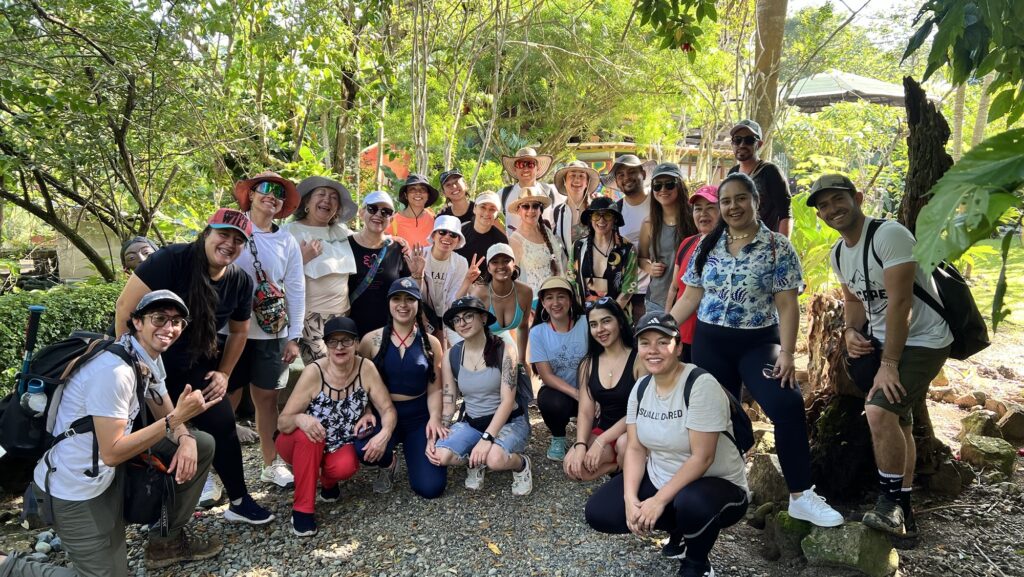
We took full advantage of the area’s natural beauty, visiting nearby Cabo Tiburón on our first afternoon, and playing in the shorebreak. Later that afternoon, we took a short hike to a nearby waterfall, and spotted some howler monkeys in the distance.
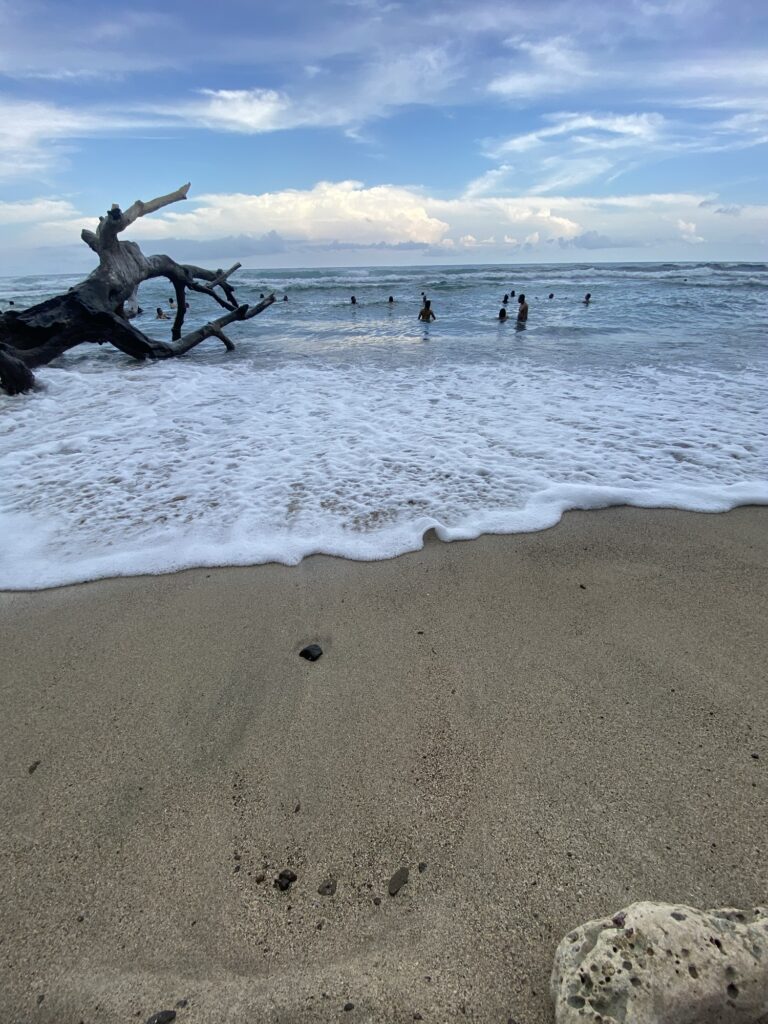
Hiking From Sapzurro to Capurganá
The next morning, our local guide Jorge met our group at the hotel. Jorge is a skinny, twenty-five-year-old caleño (from the Colombian city of Cali), brimming with energy and enthusiasm for his adopted community and the ecology of the surrounding area.
Before we left on our hike, he led us in an impassioned prayer, asking God to watch over us and allow us to enjoy the beautiful experience together. In the parts of the US where I’ve lived, this would be pretty unusual, but the Colombians didn’t bat an eye. Sometimes I feel a little weird about being such an outsider in this Catholicism-steeped nation. But Jorge’s prayer was a sweet sentiment, and soon we set off on our hike.

We walked from Paraíso Cangrejales, through Sapzurro, then inland into the forest and all the way to Capurganá. The walk took a few hours, though we made the trip in fifteen minutes by boat the day before. It rained lightly as we made the trek uphill, but we were mostly shielded by the dense forest. It cleared up by the time we stopped at a mirador, or lookout, where we climbed several flights of stairs for a view of the Sapzurro bay on one side and Capurganá on the other.
From there, we began walking downhill, and we stopped for a snack of carambola (starfruit) and bilimbí (very sour, kind of looks like an elongated green grape) that we bought from a middle-aged man selling food and drinks from his house alongside the trail. On the way, we stopped to catch glimpses of cotton-top tamarins and black-chested jays darting through the canopy.
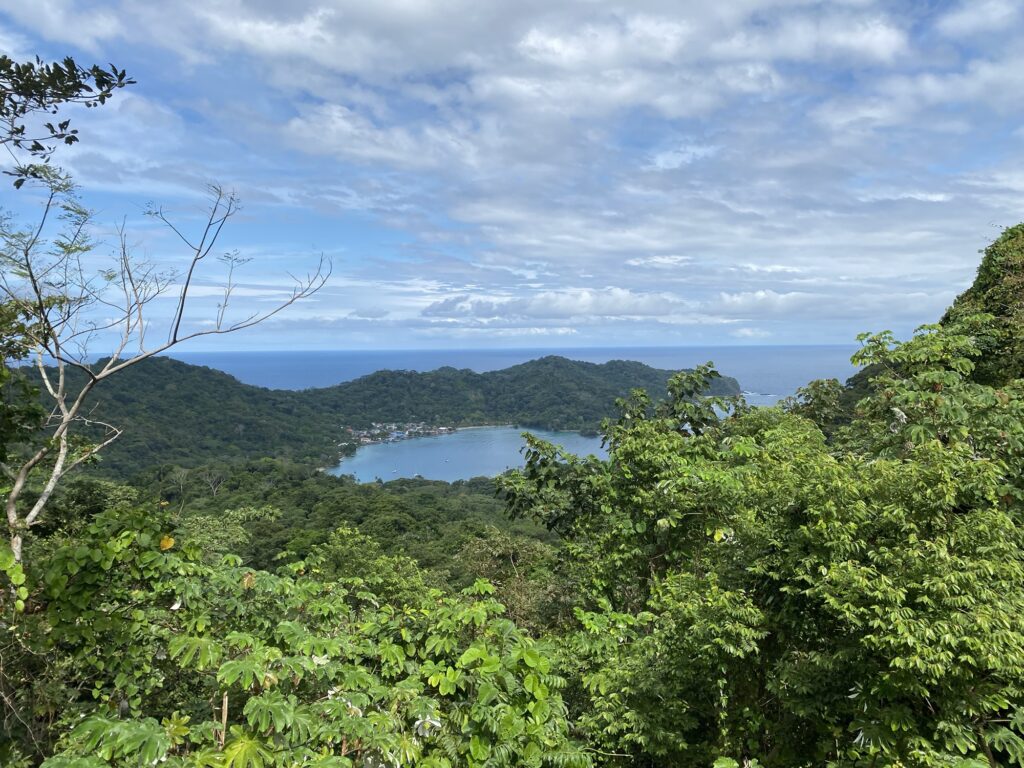
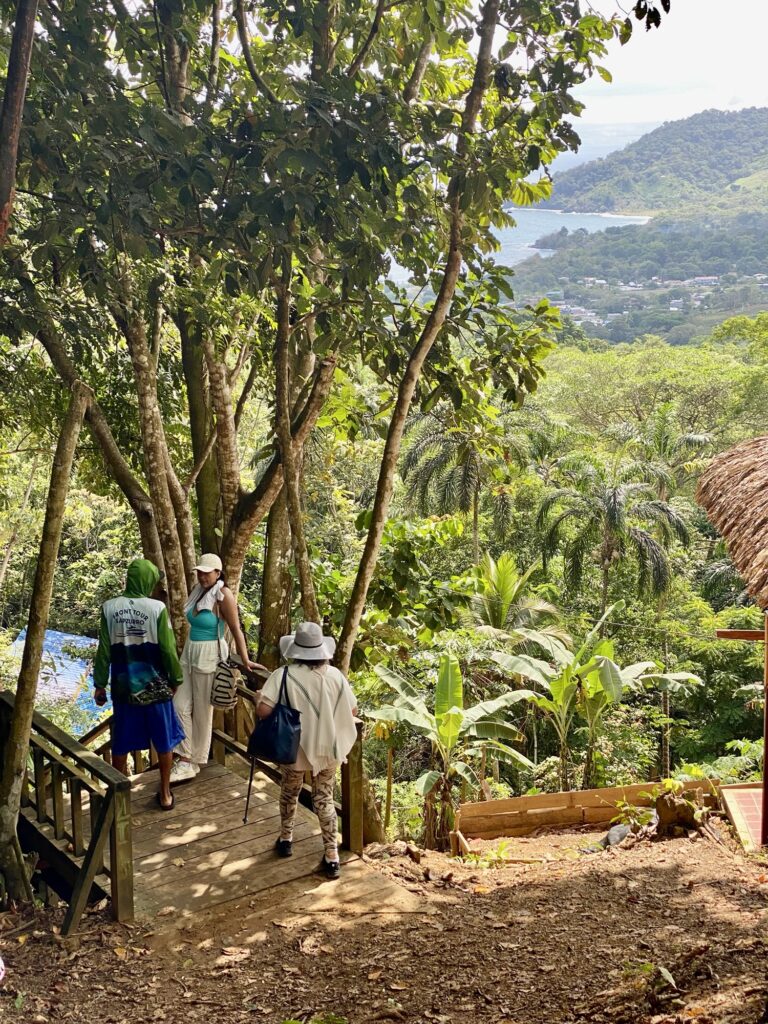
We arrived for a late lunch of fried fish, rice, and salad in a small restaurant in Capurganá. Then, we loaded up into several motocarros, which in this part of the country are motorcycles in front with an attached passenger cab made of slatted wood with two benches that fit about six adults seated knee to knee. We drove out of town in a caravan, eventually turning onto a gravel road which passed alongside and through a shallow river.
The drivers parked and let us out where the river and trail become too difficult for the motocarros to pass, and our group walked the rest of the way to Las Puertas Del Cielo (the gates of heaven), a little tourist attraction built into the river, featuring some natural and man-made pools, a small waterfall, and a little restaurant. We hiked up to another mirador before heading back down to the river to play in the pools. After a couple of hours, we went back to Capurganá in motocarros, then to Sapzurro in lanchas.
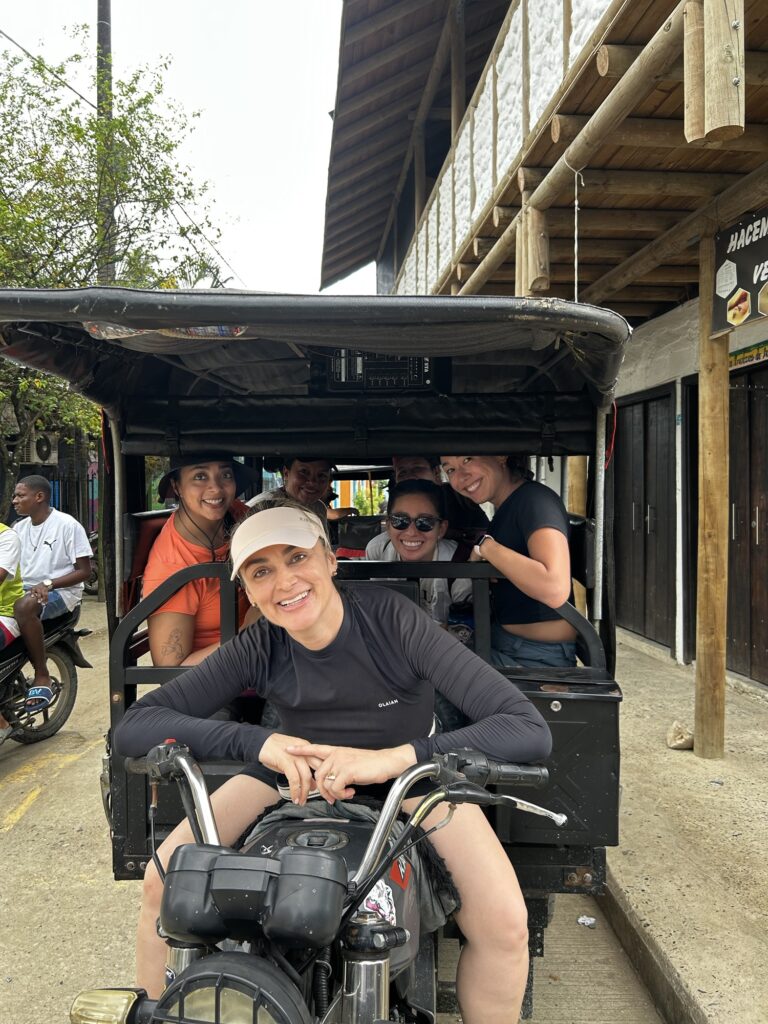
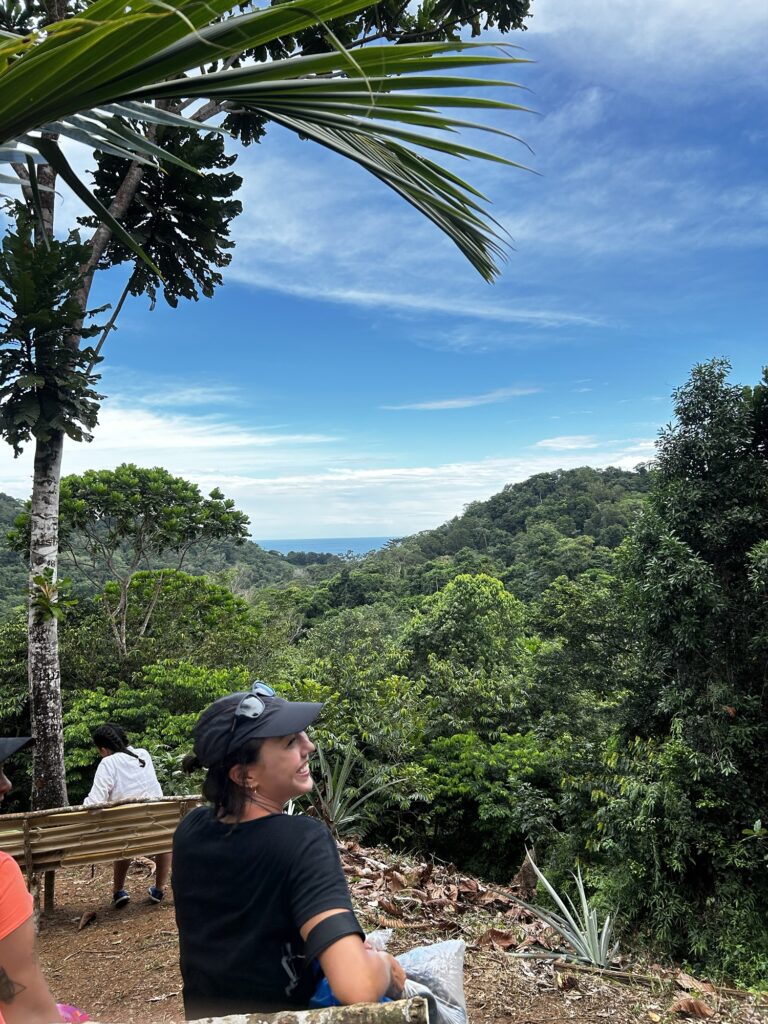
A Day at Playa La Miel, Panama
The next day, Jorge led us on another hike, this time a much shorter distance, crossing the peninsula via a set of stairs into Panama. We spent the day at Playa La Miel, which was picturesque, but it was a Sunday, and there were thousands of Colombian tourists on the beach, so the energy was a little chaotic. Our group found a quiet corner to post up, and we enjoyed swimming around the rocks and shallow reef before lunch. Lunch brought us back to the chaos as our guides LuisMi, Miguel, and Jorge filled the gaps in the beachside restaurant’s understaffed crew to make sure everyone ate.
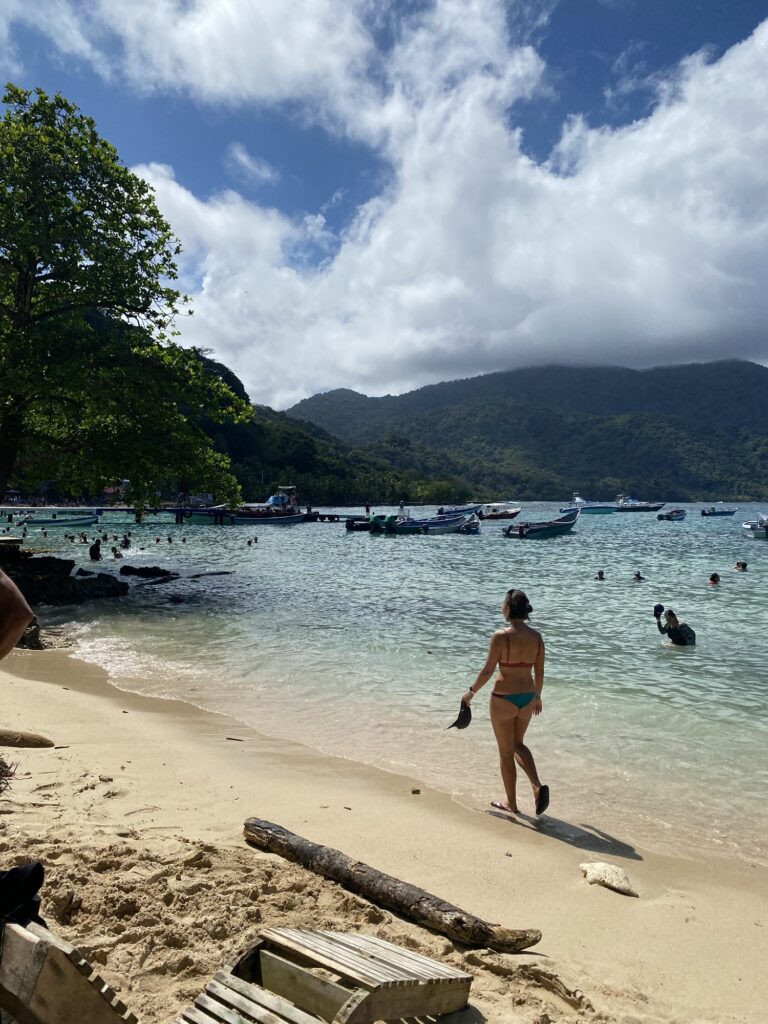
Then, more ocean time, including jumping from the concrete pier into the calm waters below. On the walk back over the stairs to Colombia, we saw more tamarins, this time up close. Then, we finished the day on the beach in Sapzurro, and some of our group joined in a pickup volleyball game.
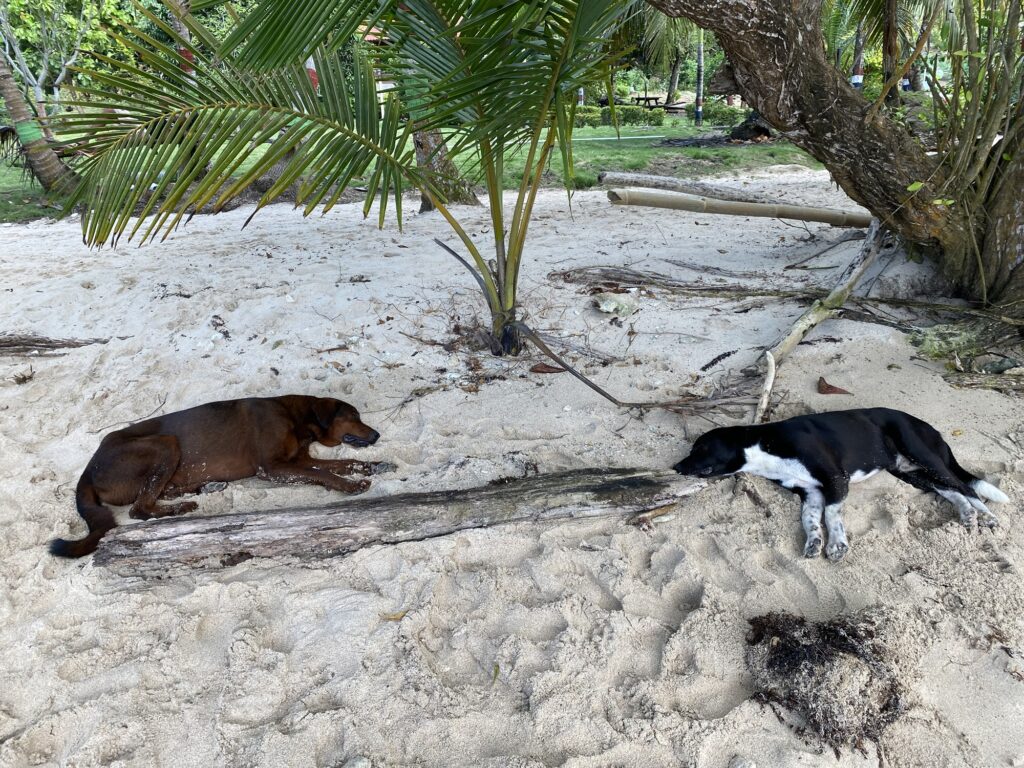
We had one last delicious dinner at the hotel as a group, after which the owner, Coset, and her family spent some time with us, telling us their story and that of the hotel. It turned out that they had a connection to San Rafael, Antioquia, where I’d spent my first month in Colombia in 2022, working on a farm at an eco-lodge. Our group had planned to go back into town that night, but after a day out in the sun and a sudden rainstorm that night, most people went to bed early. A few of us made it out for a couple of games of pool.
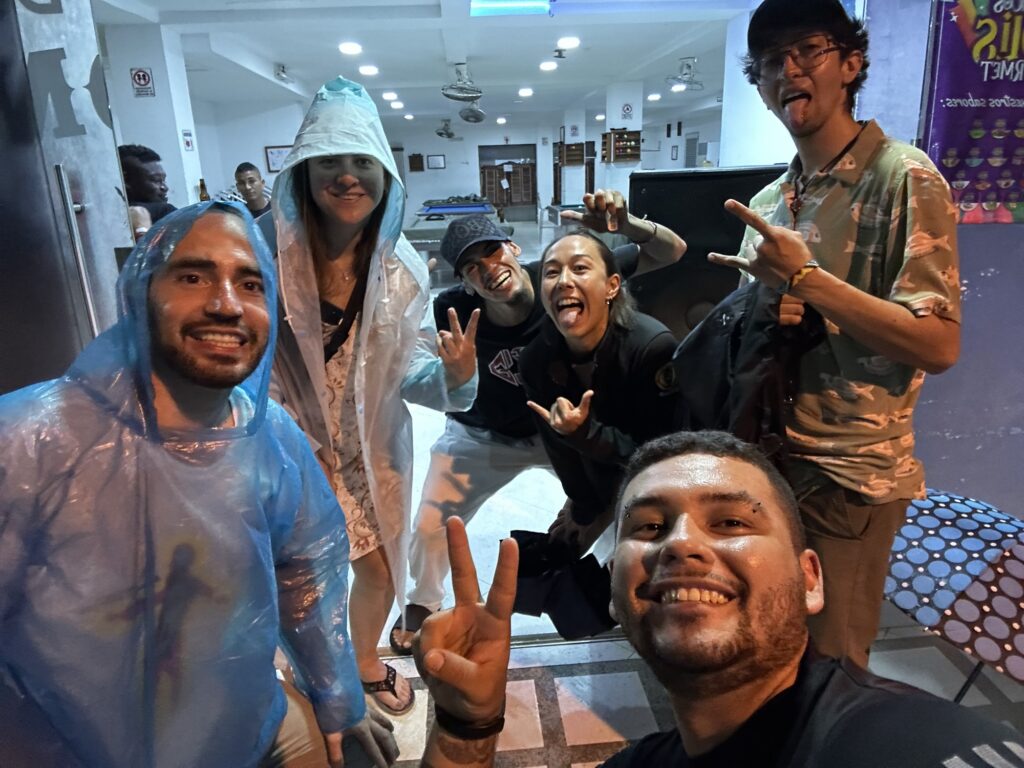
Migrants in the Darien Gap
The next morning, we got up before the sun, leaving in lanchas for Capurganá at 6:00 AM, and watching the sky turn pink over the ocean. We had a couple of hours in Capurganá before heading to Necoclí in the big boat.
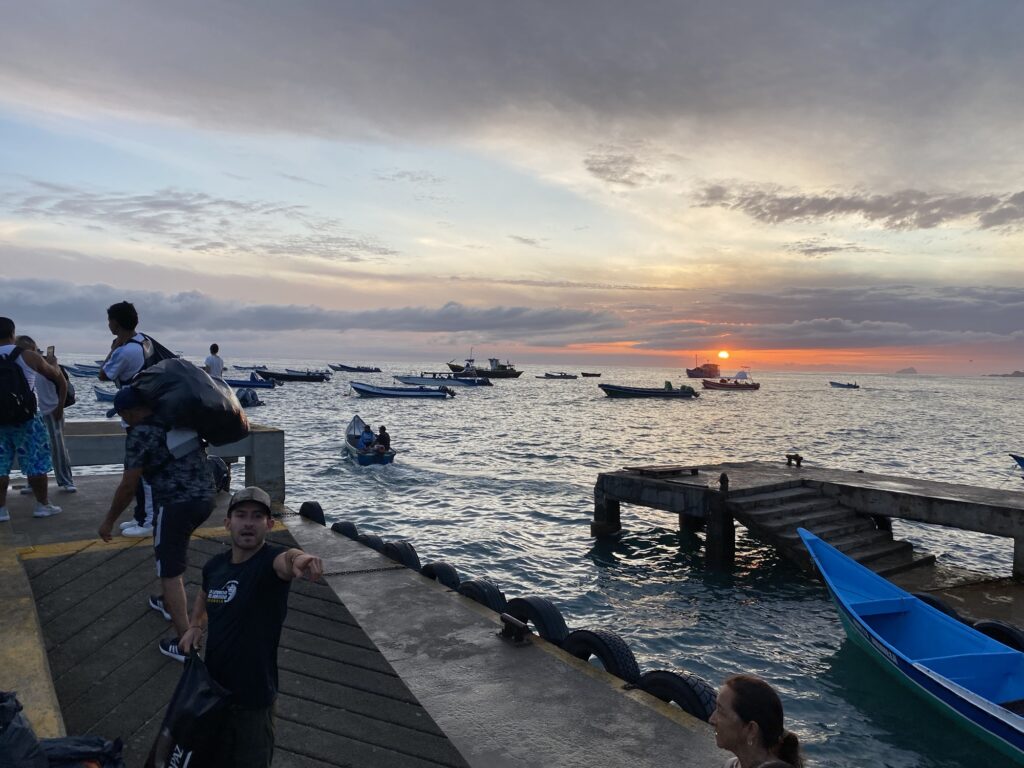
When we arrived at the docks in Necoclí, we collected our plastic-bagged luggage and I opened up the hallaca (like a Venezuelan tamal) that Coset and her staff had prepared for us as a breakfast to-go. A curious little boy approached me and started a conversation, asking me questions about where we were from and where we’d been. He said to me, No soy turista, “I’m not a tourist.” And I asked him if he was from Necoclí. No, somos migrantes, “We’re migrants,” he replied. He went on to tell me that his name was Jesús, he was Venezuelan, and he was in Necoclí with his mother, on their way to meet his father who was working in Mexico.
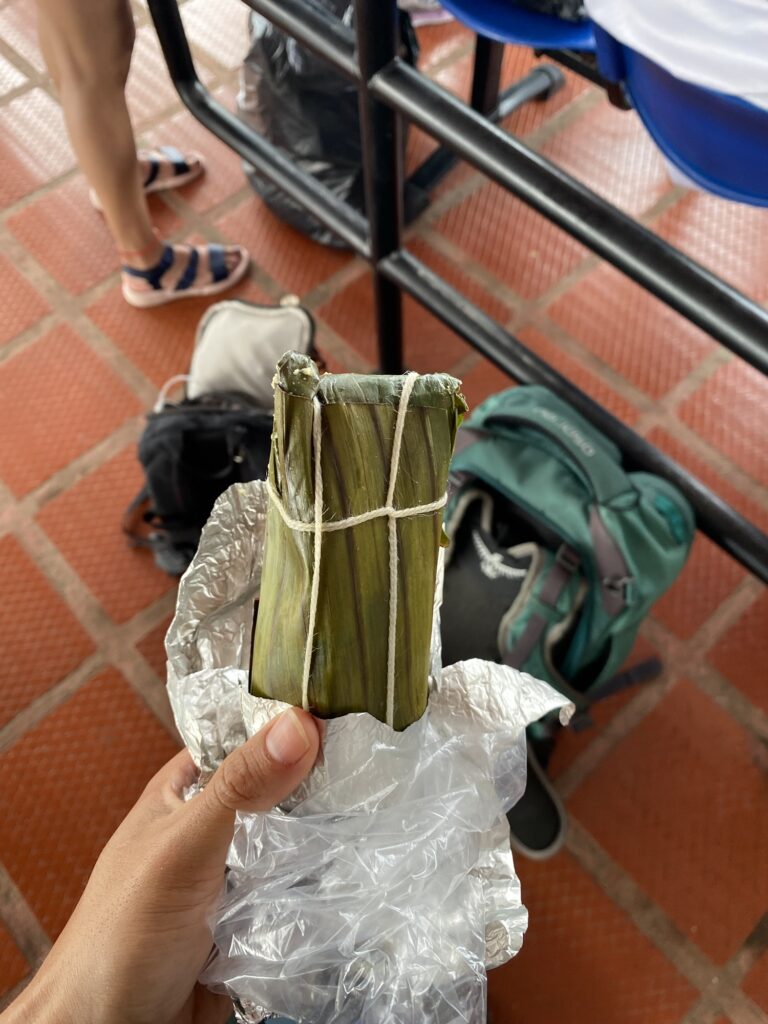
Throughout our stay in Sapzurro, the migrants had been on my mind. Sapzurro, Capurganá, and Necoclí sit inside the region known as the Darien Gap. In Spanish, it’s called El Tapón de Darién, which could be translated as “plug” or “stopper,” which to me seems more fitting. The Pan-American Highway–which would otherwise traverse North and South America from Alaska to Argentina–can’t pass through the dense forest and rugged mountains between Colombia and Panama.
It’s notoriously difficult to cross on foot as well–a plug in the flow of traffic. Many migrants begin their journey across El Tapón in Necoclí, taking lanchas either to Acandí or Capurganá, where they then begin their long walk to Panama. The journey can take ten days, and conditions are treacherous, even for strong, fit people.
While our group was hiking from Sapzurro to Capurganá, Jorge told me that the section of trail we were walking was also used by migrants. He said that a few weeks earlier, tourism in the area had been dead, but migration was up. The lanchas were filled with migrants instead of tourists on beach vacations, and the trails were lined with discarded trash. All of a sudden, around Christmas, the tourists started to arrive again, and the flow of migrants slowed to a trickle. Little Jesús was the first migrant I’d met during our trip.
The week before traveling to Sapzurro, I listened to a series of podcasts about the people crossing the Darien Gap and the challenges and dangers they face. One part that particularly impacted me was hearing about the parents who make the trip with their young children, telling them stories about the grand adventure they’re on, and trying to distract them from the dead bodies of fallen fellow travelers.
They come from all over the world. Often, they’re fleeing violence from gangs and governments. Many, like Jesús and his family, are from Venezuela, where the spiraling economic and political situation has forced out almost a third of the country’s citizens. No matter where they’ve come from, these people have decided that even the risks of El Tapón are better than what they can expect at home.
Jesús is With Me
On the docks of Necoclí, I notice Jesús eyeing my breakfast. I ask if he’s hungry and if he’ll introduce me to his mom so I can buy them something to eat. He leads me around the corner to where his mother sits on a plastic stool on the sidewalk with her youngest child, selling little plastic cups of sliced mango to passers-by. I stay to talk with them for a while–about the situation in Venezuela, their plans to earn some money in Necoclí for a few weeks before embarking on their trip through El Tapón, how their whole family is sleeping in a tent right here on the sidewalk where she sells mango.
Jesús is ten, the second-youngest of five siblings. He and his six-year-old sister stay with their mom during the day while their older siblings work in nearby restaurants. Their mom tells me that she wants Jesús and his sister to have better opportunities. They’re smart and curious, she tells me. “And very independent,” I smile at Jesús. His mom laughs and tells me he’s always chatting up everyone he meets.
We watch a flock of pelicans fly by, and they ask me what kind of birds they are. “Pelícanos,” I reply. “Have you guys seen Finding Nemo?” They nod enthusiastically, excited to connect the huge birds swooping overhead with the one who burst into the dentist’s office to save Nemo.
Jesús’ mother tells me that the week before, the kids got sick from playing in the contaminated water near the docks, so she doesn’t let them go in anymore. I ask if they know how to swim. They shake their heads. I tell them lightly that they should learn, that I grew up near the ocean, that swimming is so much fun, and maybe they’ll learn when they get to Mexico.
But I’m so afraid for them, these fragile, beautiful little ones. I know that many of the deaths in El Tapón are drownings, people swept away in one of the many river crossings. It’s so awful to know how unsafe they’ll be–in El Tapón and beyond. It’s a very long way to Mexico, and dangerous men are known to prey upon migrants at every stage of the journey. It’s even quite possible that they’ll be deported back to Venezuela from Panama.
I don’t say any of this. What can you say to a mom and her little kids who are in the midst of the worst experience of their lives? I tell her that I can’t imagine how difficult it must be, and I admire her strength. Before long, it’s time for me to get back to my group. Before I leave, I go with Jesús to one of the sidewalk food carts, and buy them a big breakfast. I hand his mom some cash, and board the chartered bus back to Manizales.
Vacation vs. Migration
It’s been a few weeks since I met Jesús and his family, so based on the timeline they gave me, I think it’s likely that they’re crossing El Tapón as I write this. I wish I had given them more money. I wish I could’ve done more to help. I hope all of them survive the journey and reunite with their dad in Mexico.
It felt strange to me, going on vacation to the edge of the Darien Gap. Even though I didn’t see any other migrants during the trip, I thought about them as we rode in lanchas along the coast, watching the dense forest bob past us, and trying to imagine spending ten days backpacking through it. Our fun day hike popped us out into the sunshine and a hot lunch in Capurganá, but Jesús would walk the same trail in the other direction, embarking on a harrowing journey into El Tapón.
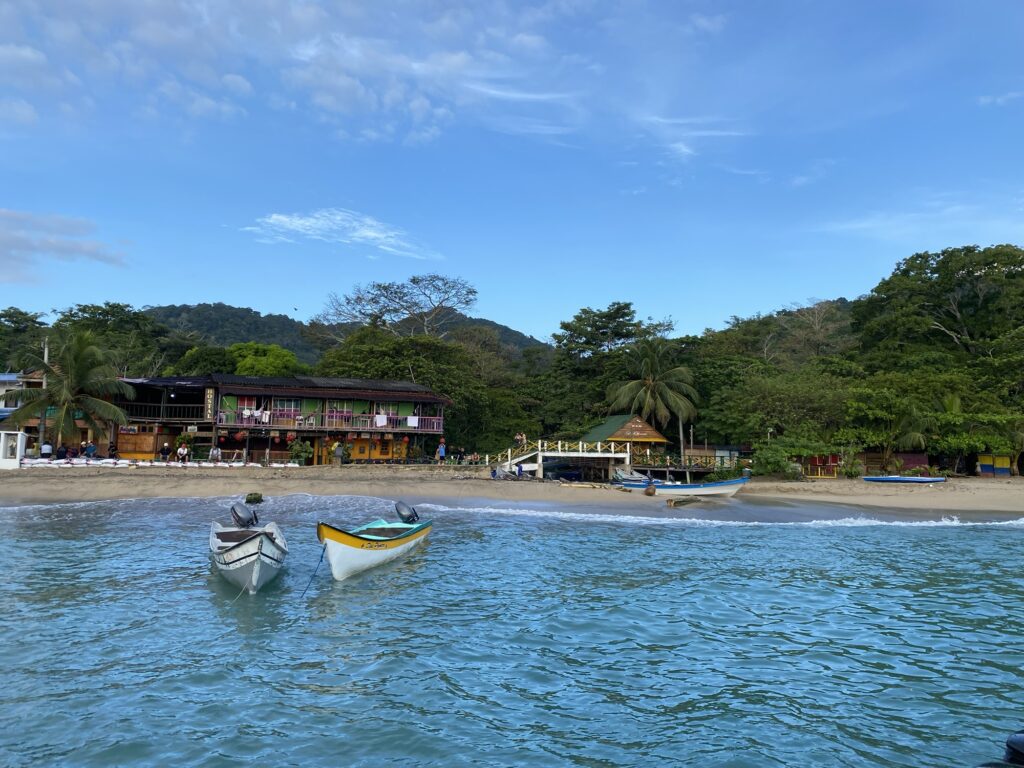
Dropping tears as I read this…..beautiful and sad all at once.